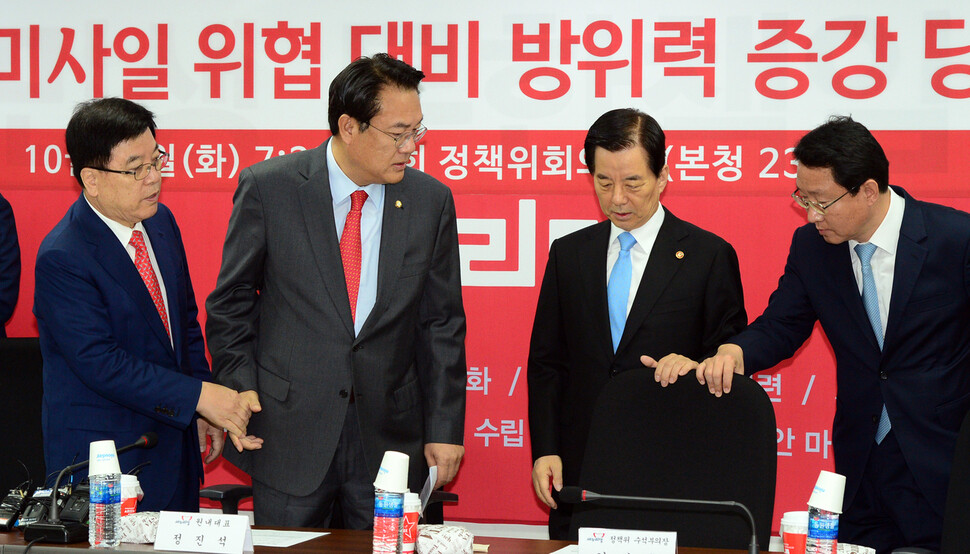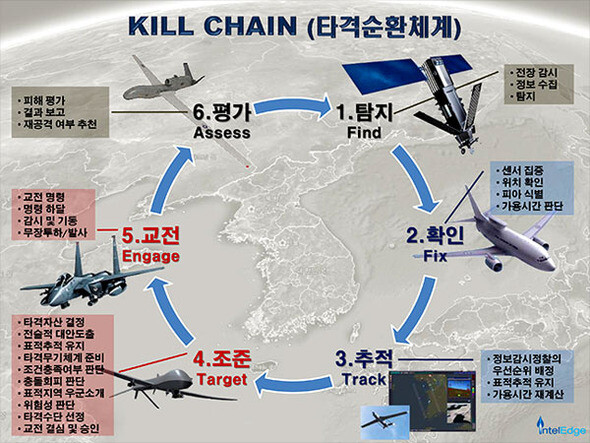hankyoreh
Links to other country sites 다른 나라 사이트 링크
South Korea moves up schedule for three programs to counter N. Korean nukes

On Oct. 18, the South Korean government and the ruling Saenuri Party agreed to move forward the implementation of three programs aimed at countering North Korea’s nuclear threat. The three programs - the kill chain, the Korean Air and Missile Defense (KAMD) and the Korean Massive Punishment and Retaliation (KMPR) - were initially scheduled to be ready by the mid-2020s, but that has been pushed forward to the early 2020s.
This plan was announced by Kim Gwang-lim, chair of the Saenuri Party’s policy committee, during a discussion about strengthening defensive countermeasures for North Korea’s nuclear program that took place in the National Assembly on Oct. 18 and was attended by Saenuri Party floor leader Chung Jin-suk and Defense Minister Han Min-koo, among others.
The government and the Saenuri Party are planning to accelerate programs that have already been confirmed but which have been delayed because of budget shortfalls. Consequently, the government is planning to include the acquisition of two more early warning radars for ballistic missiles in next year’s budget. It will also consider renting foreign satellites until a spy satellite can be deployed in 2021 or 2022.
The South Korean government is also planning to purchase additional Taurus long-range air-to-surface missiles and helicopters for maritime applications earlier than scheduled. “It will cost an additional 200 or 300 billion won [US$178-267 billion] to move our defense upgrades forward by about one year,” Kim Gwang-lim said.
The Saenuri Party also urged the government to actively explore the idea of moving forward plans to acquire nuclear submarines. “These are matters to review in consideration of the effectiveness of military operations, technical feasibility and the military plans of our neighbors,” the Defense Ministry said in response.
The government and the Saenuri Party did not discuss the possibility of rescheduling the timing of South Korea transferring wartime operational control (OPCON) of its forces as part of accelerating plans to implement these three defense programs. After South Korea and the US agreed to another delay of the OPCON transfer in Oct. 2014, South Korean Defense Minister Han Min-koo said that the transfer would probably occur after South Korea develops the kill chain and KAMD in the mid-2020s.

By Park Byong-su, senior staff writer and Kim Jin-cheol, staff reporter
Please direct questions or comments to [english@hani.co.kr]

Editorial・opinion
![[Column] Park Geun-hye déjà vu in Yoon Suk-yeol [Column] Park Geun-hye déjà vu in Yoon Suk-yeol](https://flexible.img.hani.co.kr/flexible/normal/500/300/imgdb/original/2024/0424/651713945113788.jpg) [Column] Park Geun-hye déjà vu in Yoon Suk-yeol
[Column] Park Geun-hye déjà vu in Yoon Suk-yeol![[Editorial] New weight of N. Korea’s nuclear threats makes dialogue all the more urgent [Editorial] New weight of N. Korea’s nuclear threats makes dialogue all the more urgent](https://flexible.img.hani.co.kr/flexible/normal/500/300/imgdb/original/2024/0424/7317139454662664.jpg) [Editorial] New weight of N. Korea’s nuclear threats makes dialogue all the more urgent
[Editorial] New weight of N. Korea’s nuclear threats makes dialogue all the more urgent- [Guest essay] The real reason Korea’s new right wants to dub Rhee a founding father
- [Column] ‘Choson’: Is it time we start referring to N. Korea in its own terms?
- [Editorial] Japan’s rewriting of history with Korea has gone too far
- [Column] The president’s questionable capacity for dialogue
- [Column] Are chaebol firms just pizza pies for families to divvy up as they please?
- [Column] Has Korea, too, crossed the Rubicon on China?
- [Correspondent’s column] In Japan’s alliance with US, echoes of its past alliances with UK
- [Editorial] Does Yoon think the Korean public is wrong?
Most viewed articles
- 1‘We must say no’: Seoul defense chief on Korean, USFK involvement in hypothetical Taiwan crisis
- 2N. Korean delegation’s trip to Iran shows how Pyongyang is leveraging ties with Moscow
- 3Amnesty notes ‘erosion’ of freedom of expression in Korea in annual human rights report
- 4‘Weddingflation’ breaks the bank for Korean couples-to-be
- 5[Reportage] On US campuses, student risk arrest as they call for divestment from Israel
- 6[Column] Park Geun-hye déjà vu in Yoon Suk-yeol
- 7Korea sees more deaths than births for 52nd consecutive month in February
- 8[Editorial] New weight of N. Korea’s nuclear threats makes dialogue all the more urgent
- 9Will NewJeans end up collateral damage in internal feud at K-pop juggernaut Hybe?
- 10[Guest essay] The real reason Korea’s new right wants to dub Rhee a founding father